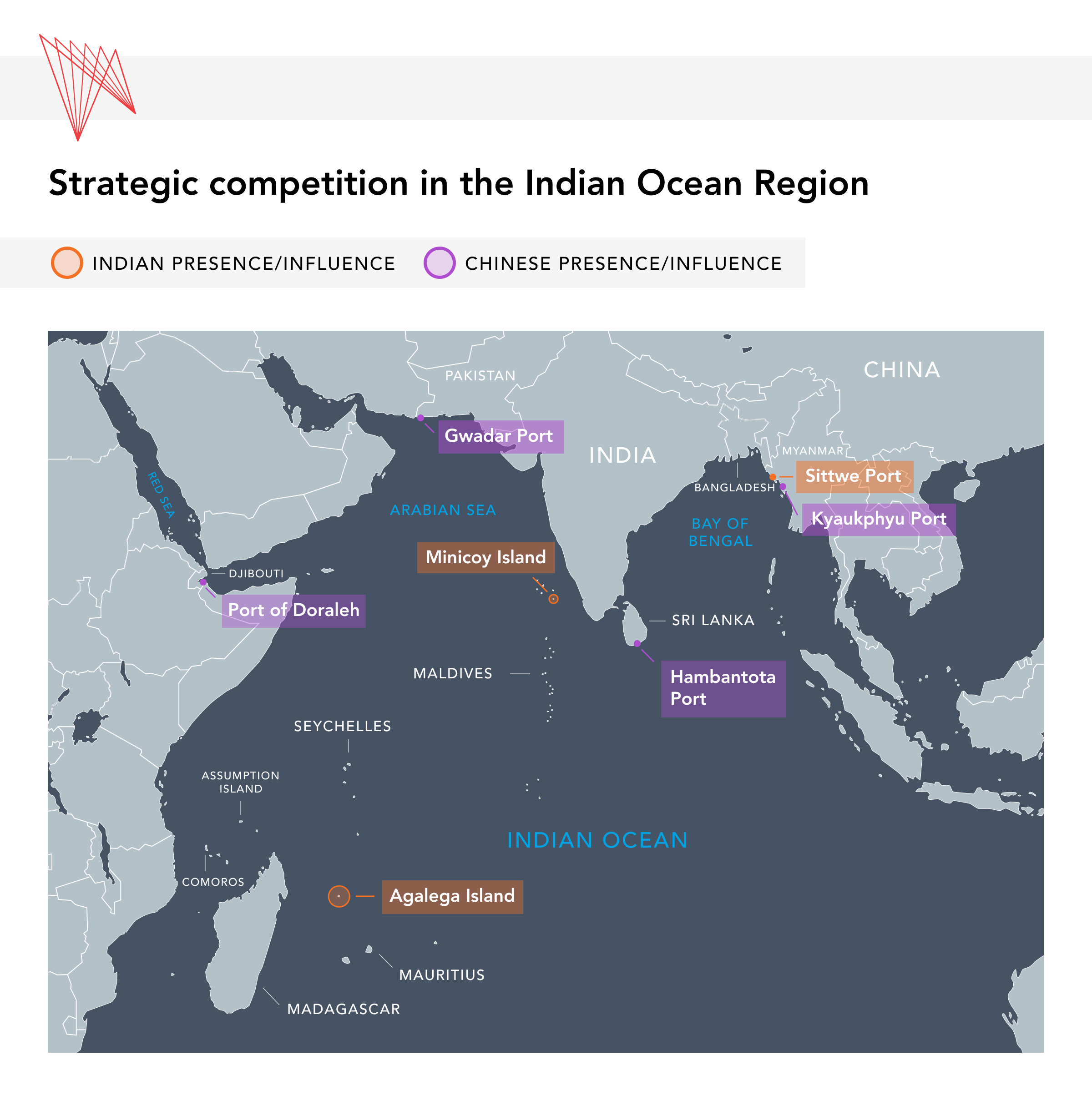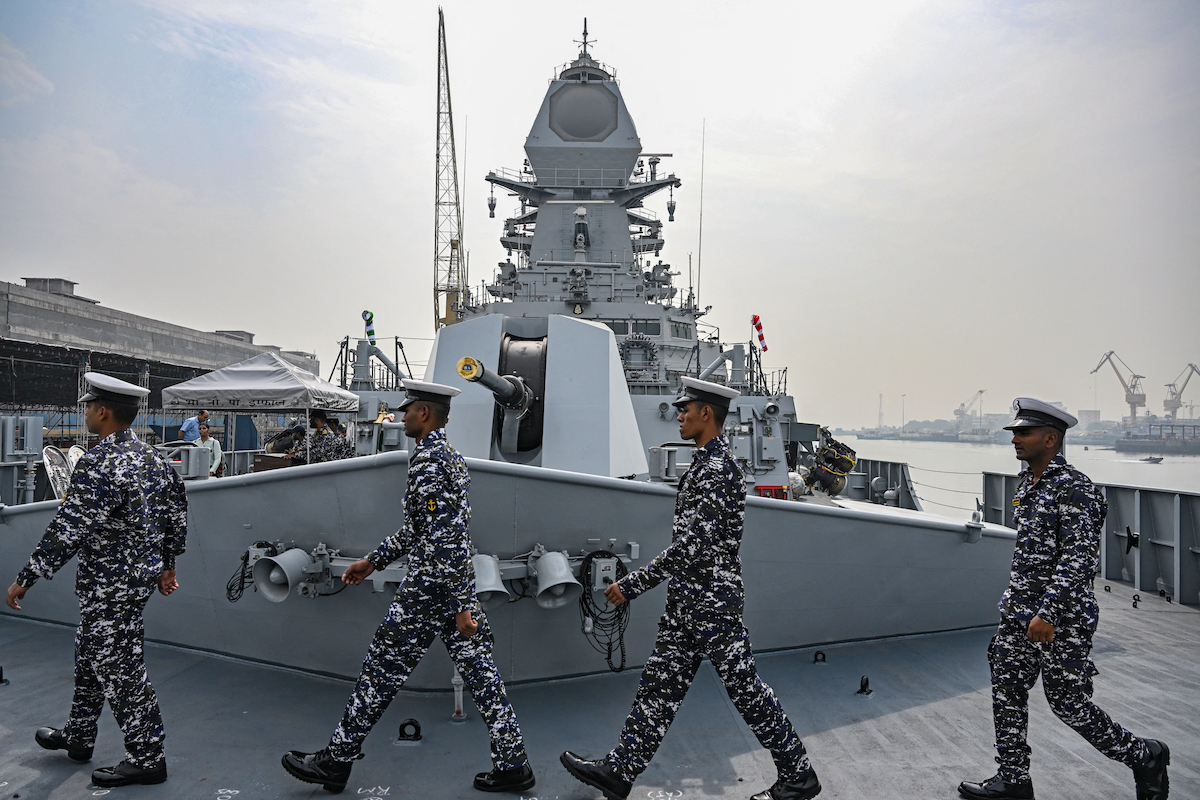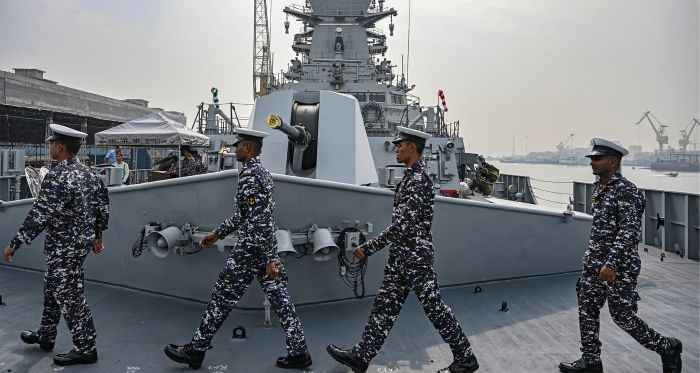India’s strategic outlook has long focused on continental challenges, particularly from Pakistan and China, relegating maritime concerns to the back burner. However, the Indian Ocean Region, which New Delhi has traditionally viewed as part of its sphere of influence, is becoming a much higher strategic priority, especially as China’s influence in the region rises.
The Indian Ocean Region is generally understood to encompass the land and ocean territory that stretches from the Strait of Malacca in the east to the Mozambique Channel in the west and includes the Arabian Sea, the Bay of Bengal, the Gulf of Aden, the Persian Gulf, the Red Sea, and 33 littoral countries with a combined population of about 2.9 billion.
This region’s significance lies in its vital maritime routes that allow international trade via oceans and serve as ‘strategic highways.’ These routes – called sea lines of communication (SLOCs) – connect the Middle East, Southeast Asia, East Asia, Europe, and the Americas and are crucial for global economic security. The strategic rivalries in the region today revolve around maintaining military and strategic dominance near crucial chokepoints along SLOCs, where nations jostle to safeguard or deny others free navigation.
For India, the Indian Ocean Region is strategically vital because roughly 80 per cent of its crude oil and 95 per cent of its trade (by volume) are transported via seas and oceans. The increase in Chinese infrastructure investments, ports, and military installations in the area has heightened New Delhi’s sense of insecurity and underscored the close link between traditional security imperatives and economic interests tied to maritime trade routes.

China and the ‘string of pearls’ theory
For years, India’s land-border conflicts with Pakistan and China have constituted a kind of “continental obsession” that elevated the country’s army and air force and left its naval capabilities somewhat neglected. However, a re-prioritization of India’s defence objectives has been underway for roughly a decade, mainly in response to China’s expanding presence and influence in the region. This includes the network of naval bases and commercial facilities that China has built to connect its mainland to Port Sudan. This network – referred to as the ‘string of pearls’ in a 2005 U.S. Department of Defense report – is perceived by India and others as having encircled India in the maritime domain.
While Beijing has vigorously repudiated suggestions of encirclement – a strategic tactic to isolate and surround an adversary on all sides – the spread of Chinese influence through its maritime ‘Belt and Road Initiative’ (BRI) has exhorted both New Delhi and several Western capitals to take the ‘encirclement’ threat seriously. For example, five of India’s six South Asian neighbours have joined the BRI – Bangladesh, the Maldives, Nepal, Pakistan, and Sri Lanka. All of these, except Nepal, are Indian Ocean states. Beijing has also invested in infrastructure projects and sought to use ports in Bangladesh, Maldives, Myanmar, Pakistan, and Sri Lanka. While China’s use of these ports may be for commercial purposes, the possibility that they could be used militarily is a source of alarm for New Delhi.
Beyond South Asia, Beijing’s involvement in building the Kyaukpyu Port in Myanmar would also allow it to challenge the Indian Navy’s previously unchallenged dominance in the Bay of Bengal. New Delhi is also wary of the possible militarization of the Gwadar Port in Pakistan and the establishment of a Chinese military base in 2017 in Djibouti on the Horn of Africa.
Finally, Beijing has intensified its diplomatic outreach to Indian Ocean states and is the only major power with a diplomatic mission in each of the region’s six island nations — the Comoros, Madagascar, the Maldives, Mauritius, Seychelles, and Sri Lanka.
Sri Lanka and the Maldives inch closer to China’s orbit
Recent developments in Sri Lanka and Maldives underscore the India-China competition for influence. Beijing’s acquisition in 2017 of a 99-year lease of Sri Lanka’s Hambantota Port after the Sri Lankan government defaulted on its debt payments to Beijing is viewed by many in India and the West as an example of Chinese ‘debt trap diplomacy,’ a charge that Beijing denies.
New Delhi fears that Chinese ‘research’ vessels docked at Hambantota could be deployed for surveillance of India’s military capabilities. For instance, Chinese ships would be able to gauge the range and accuracy of Indian missiles tested nearby. In 2023, Colombo imposed a one-year ban on Chinese and other foreign research vessels docking at Hambantota, apparently in response to protests from New Delhi. However, the ban was reversed in March 2024 after Beijing reportedly exerted diplomatic pressure on Colombo. Colombo presently claims that it is only allowing docking of foreign ships for replenishment purposes, not for research, and that it has not allowed any Chinese ‘research’ vessels to dock.
In the Maldives, following his election in November 2023, President Mohamed Muizzu began distancing his country from India and embracing closer ties with China. Before he became president, Muizzu launched an ‘India-Out’ campaign, demanding a complete withdrawal of the 89 Indian troops stationed in Maldives for disaster relief and other purposes (which could include surveillance). On March 4, the Maldives government “signed an agreement on China’s provision of military assistance gratis to the Republic of Maldives,” although details of what this assistance entails are not publicly available.
India’s response to China’s rising influence
Upgrading maritime doctrines and military capabilities
In its inaugural naval doctrine in 2004, India emphasized freedom of navigation and safeguarding vital maritime trade and communication routes. The strategy was last updated in 2015 and suggested a more proactive approach of “enhancing net security in India’s areas of maritime interest.” The concept of being a “net security provider” typically refers to bolstering collective security by tackling shared challenges like combating transnational piracy or co-ordinating disaster relief efforts. India’s naval strategies have evolved from prioritizing ‘sea control’ to emphasizing ‘sea denial,’ suggested by its intention to acquire submarines. Sea control entails ensuring dominance in maritime territories; sea denial is a tactic to neutralize an adversary’s war-waging capabilities by preventing them from accessing critical areas.
India also embraced the emergent geostrategic concept of the ‘Indo-Pacific’ in 2015, viewing the Indian Ocean and the Western Pacific as a single strategic theatre. Taking its “neighbourhood first” policy a notch further, Prime Minister Narendra Modi in 2015 inaugurated the ‘Security and Growth for All in the Region’ (SAGAR) doctrine, which consolidates the idea of the ‘Indo-Pacific’ in India’s strategic outlook and advocates for the region to be “free, open, inclusive, peaceful, and prosperous.” The SAGAR doctrine is a close cousin of the Indo-Pacific strategies of Canada and the U.S.
India is also working to narrow the wide gap between its naval capabilities and those of China. New Delhi has beefed up its naval budget – the largest increase in the overall defence budget in 2023 was for the navy to modernize its warships, augment its fleet, and incorporate new technologies. The navy test-fired ship-launched versions of the BrahMohs supersonic cruise missile in March 2023, is set to benefit from the purchase of MQ-9B SeaGuardian drones from the U.S., and is building submarines and aircraft carriers. INS Vikrant, its first indigenous aircraft carrier, was commissioned in 2022.
Nevertheless, India’s maritime fleet has only 132 warships, while China has 370 warships, a number expected to rise to 435 by 2030. Beijing’s new Type 096 nuclear-armed submarines are extremely hard to detect, posing an additional challenge not just for India but also for the U.S. and its allies, which are closely monitoring China’s naval movements and capabilities.
India’s bid to gain influence among Indian Ocean states
In February 2024, Indian Prime Minister Modi inaugurated an airstrip, a jetty, and six developmental projects, all completed with New Delhi’s assistance, on the strategically significant Agalega Island of Mauritius, which has been experiencing incursions from Chinese warships. In April 2024, the Indian Ministry of External Affairs approved the proposal by India Ports Global, an Indian state-owned company, to run the operations of the Sittwe Port in Myanmar, also built with New Delhi’s assistance. Additionally, India recently inaugurated a new naval base, the INS Jatayu, on Minicoy Island in its strategically critical union territory of Lakshadweep, off the coast of Kerala in the Laccadive Sea, now the “nearest major military installation to the Maldives.”

To demonstrate its steadfast friendship with Sri Lanka, New Delhi extended more than US$4 billion in assistance when the former was neck-deep in an economic crisis in 2022. Moreover, in 2023, India’s Adani Group became part of a consortium working to expand the Colombo Port’s deepwater West Container Terminal, which was financed with a US$550 million loan from the U.S. International Development Finance Corporation.
However, challenges remain for New Delhi. Its ambition of establishing a base in the Seychelles’ Assumption Island, driven by the need to guard vital SLOCs and to counter the Chinese base in Djibouti, hit a roadblock after a change in the Seychelles’ government in 2020. The new government stalled the project due to concerns about the island’s sovereignty and possible environmental impacts.
Nevertheless, by showing support for countries like Sri Lanka and Mauritius, India can regain the confidence of other small littoral states that may need assistance to protect their waters and promote economic growth. Furthermore, if India wants to remain a net security provider, it must establish a stronger presence in the western Indian Ocean Region, where China is at a geographical disadvantage due to its more distant location. New Delhi’s efforts in Agalega and Minicoy are significant in this context to ensure its access to the entire western Indian Ocean.
India’s ascendant role in maritime governance alongside ‘like-minded’ nations
The 23-member Indian Ocean Rim Association (IORA), created in 1997 primarily to promote economic objectives, has emerged as a vital multilateral platform for maritime security and governance in the Indian Ocean Region. As a founding member, India has sought to revive the body as part of its regional leadership strategy. The platform is also perceived as a mechanism to contain Beijing’s influence, as neither China nor its close ally Pakistan are full members. (China and the U.S. are dialogue partners.)
India is also participating in naval exercises in the Indian Ocean and in ‘mini-lateral’ efforts with countries that share its maritime strategic objectives, such as deterring or containing what they view as Chinese assertiveness and ensuring freedom of navigation. Examples include the India-Japan-U.S. Dialogue, the Australia-India-Indonesia Trilateral Dialogue, and most notably, the Quadrilateral Security Dialogue (QUAD), comprising Australia, India, Japan, and the U.S.
The Malabar exercises comprising India, Australia, Japan, and the U.S., the India-Brazil-South Africa Maritime (IBSAMAR) exercises, and the biennial multinational Milan exercises are other examples of naval exercises that promote similar objectives. Canada’s participation in Milan 2024 could be an incubator for further co-operation between Canada and India in other strategic theatres in the Indo-Pacific.
As a reflection of India’s growing maritime strategic partnership with the West, media reports in March 2024 revealed that U.S. and U.K. warships traversing the Indo-Pacific region were docking at India’s Chennai Port for maintenance and repair. In light of this development, India seems to have accepted its role as a maritime centre for the maintenance of vessels deployed by its partners in the Indo-Pacific in an effort to secure their shared strategic interests.
What’s next for India and the Indian Ocean Region?
While India’s strategic reorientation towards the maritime domain reflects a seismic shift in its geopolitical calculus, there are two main important caveats in its efforts to become a significant maritime power.
First, India’s intensifying efforts to bolster its maritime capabilities include a comprehensive modernization drive, with significant investments in naval technology and infrastructure. However, closing the gap with China will be daunting, as the latter’s fleet and technological edge are formidable.
Second, while India is actively cultivating strategic partnerships with small island nations in the Indian Ocean Region, the Maldives and Sri Lanka are a stark reminder that its role as a regional hegemon has waned. Continually supporting such littoral states will be crucial for building trust and co-operation with these states.
New Delhi’s role in fostering partnerships to protect the Indian Ocean Region may be mutually beneficial for regional states and extra-regional actors such as Canada and the U.S. to secure a ‘free and open Indo-Pacific.’ While these evolving partnerships are frequently labelled ‘strategic’ initiatives, there is also a convergence of both interests and values among the relevant states, including India and Canada, in promoting economic prosperity, freedom of navigation in the seas, and a rules-based international order.






